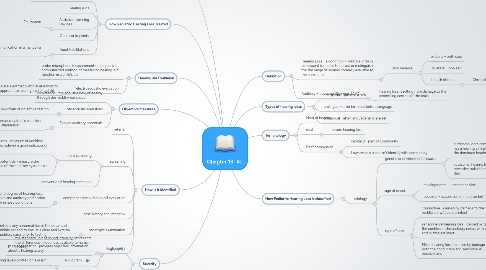
1. Hearing aid Evaluaion
1.1. probe microphone measurement- an objective, computerized method of measuring hearing-aid function in a child's ear
1.2. electroacoustic evaluation
1.2.1. audiologists use electroacoustic evaluations to choose an appropriate hearing aid for a child
2. Objective measures
2.1. immittance - the acoustic flow of energy through the middle- ear space
2.2. otoacoustic emissions
2.2.1. relatively new form of objective testing
2.3. Evoked auditory potentials
2.3.1. test the auditory nervous system's electrical response to sound stimulation
3. How is it identified
3.1. referral
3.2. screening
3.2.1. infant screening
3.2.1.1. otoacoustic emissions - measure of cochlear function and are considered a good indicator of hearing acuity
3.2.1.2. evoked auditory potentials - measure the electrical response of the auditory system to a sound stimulus
3.2.2. conventional hearing screening
3.3. comprehensive audiological evaluation
3.3.1. assesses the type and degree of hearing loss, speech discrimination and auditory perception abilities in quiet and in nosy conditions
3.4. case history and interview
3.5. otoscopic examination
3.5.1. detects any abnormalities in the outer and middle ear and to ensure a clear and external auditory canal prior to testing
3.6. Audiometry
3.6.1. pure-tone testing- provides objective information about a hearing acuity
4. Severity
4.1. decibels
4.1.1. the standard unit of sound intensity, represents the differences in loudness available to human hearing
4.1.2. audiogram
4.1.2.1. hearing levels plotted on a graph
4.2. threshold
4.2.1. earliest point at which a person can begin to hear
4.3. Medical/Ambulance
5. How Pediatric Hearing Loss Treated
5.1. amplification and listening devices
5.2. Hearing Aids
5.3. Assistive Listening Devices
5.3.1. FM system
5.4. Cochlear Implants
5.5. Aural Habilitations
5.5.1. achieve fluent communication in a manual or oral modality
6. Auditory Processing Disorders
6.1. type of hearing loss that adversely affects an individuals processing, or interpretation, of auditory messages
7. Definition
7.1. Hearing Loss - a condition in which a child or adolescent is unable to detect or distinguish the the range of sounds normally available to the human ear
7.1.1. Very Variable
7.1.1.1. bilateral - both ears
7.1.1.2. unilateral - one ear
7.1.1.3. Length of time
7.1.1.3.1. Chronicity
7.2. Auditory Processing Disorders (APD)
7.2.1. Hearing loss resulting from damage to the processing centers of the brain
8. Types of hearing losss
8.1. congential - present a birh
8.2. prelingual - after birth but before language
8.3. poslingual - after language skills are est
9. Terminology
9.1. Hard of hearing
9.2. deaf
9.2.1. severe hearing loss
9.3. Deaf community
9.3.1. capital D= part of community
9.3.2. Lowercase d = doesn't identify with community
10. How Pediatric Hearing Loss is classified
10.1. etiology
10.1.1. genetic or environmental cause
10.1.1.1. autosomal dominant hearing loss - one parent has a hearing a hearing loss and is a carrier of the dominant hearing loss gene
10.1.1.2. autosomal hearing loss - both parents carry a recessive trait for hearing loss but neither are deaf
10.1.2. age of onset
10.1.2.1. developmental - present at birth
10.1.2.2. acquired - occurs sometime after birth
10.1.3. type of loss
10.1.3.1. conductive - caused by damage to the outer or middle ear w/ cochlea intact
10.1.3.2. sensorineural hearing loss - caused by damage the cochlea or the auditory nerve, with the outer and middle ear inact
10.1.3.3. Mixed hearing loss - caused by damage to both the conductive and sensorineual mechanisms
